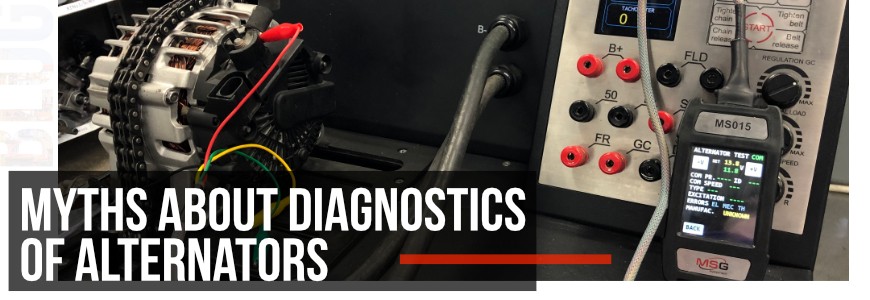
An alternator is a real «workaholic» among other automotive units of a car. It converts crankshaft rotation-generated mechanical power into the electric one that powers all the electric and electronic systems of the car and charges the battery. The unit is intended for long service life, but it is not ever-lasting either. The key enemies of today’s alternators and their older versions are temperature falls, moisture, and dust that eventually cause mechanical and electrical failures.
There are a lot of articles and videos teaching how to diagnose the alternator all by oneself. These training videos are viewed and commented on by thousands of people, which means that this issue is a concern of many.
Let’s analyze several methods of unassisted alternator testing, and decide whether these methods are informative, safe, and applicable for modern alternators.
Method 1. Testing of alternators with a multimeter directly in a car
This diagnostic technic has never been 100% informative as it is impossible to detect all the modern alternator faults simply by measuring voltage. At the very least, we need to determine whether the alternator transmits signals to the electronic control unit and how it responds to the voltage change commands transmitted from the ECU.
In addition, obtaining of a reliable information just by measuring voltage across the terminals is impossible because any car battery serves as a voltage fluctuations filter. Among other issues, the battery's good health is an essential condition for this kind of diagnostics.
Method 2. Testing of alternators on the table with the use of electric drill and lamp
This old-fashioned testing procedure requires a connection of usual bulb and drill to the alternator. A drill provides the alternator drive, while a bulb is an indicator: if the light is on, the alternator is generating current.
Still, the alternator’s ability to generate current doesn’t mean it is faultless and can be installed back to the car. The output parameters of a modern alternator must conform to certain values. To measure them, special equipment is necessary.
That’s why the “drill and bulb” technic won’t work for modern alternators.
Method 3. Testing of alternators with an oscilloscope.
Probably, this is the most precise diagnostic technic among those, offered on the internet. It is efficient for a majority of alternators with simple voltage regulators. However, this method requires a good knowledge of the alternator operation algorithm. If this is the case, a precise assessment of the unit performance is possible. For example, some voltage regulators cut off the battery when it is fully charged. In others, the battery is cut off when the engine is running at idle speed or when it revs up.
An oscilloscope can also be used for checking the alternator respond to the ECU voltage change command.
How to test the alternator of a present-day car?
Correct and advanced diagnostics requires specific knowledge and use of professional equipment. A state-of-the-art adapter for careful and precise diagnostics has already been engineered and is performing well.
MSG Equipment designed a low-budget adapter MS015 COM for rapid diagnostics of alternators of all modern types (COM (LIN, BSS), SIG, RLO, RVC, C KOR., C JAP., P-D) with rated voltage of 12V.
Benefits and advantages of MS015COM Adapter:
- Simulates signals the electronic control units transmits to the alternator and reads data the alternator transmits to the control unit.
- The tester identifies voltage-regulator ID, protocol type, errors, and data exchange speed for COM alternators operating under LIN and BSS protocols. This information is helpful when it is necessary to select a new non-original voltage regulator to replace the faulty one. In this case, the agreement of the above-stated parameters of original and non-original units is important.
- The device is equipped with a simple oscilloscope to detect alternator failures, for example, stator winding or rectifier faults.
- For ease of testing, standard diagrams for connection to the voltage regulator are displayed on the screen.
- The resistive screen allows wearing gloves during tester operation.
MS015 COM Adapter is a simple and user-friendly device that possesses high potential. It is an asset both for small auto workshops and big service centers. The use of MS015 COM adapter allows specialists to improve the capabilities of already existing test benches for alternators. Also, it gives the opportunity to design new devices as the only thing that needs to be done is provide the alternator drive while MS015 COM will control and test the unit.
Summary
Don’t shock the alternator and electronic system of your car by voltage drops resulted from the disconnection of the battery terminal when the engine is still running. Either, there is no point in setting up a medieval laboratory equipped with drills and bulbs. "Shock" diagnostics may cause damage not only to the alternator of a present-day car but to its electronic systems as well. Besides, these diagnostic methods are not informative.
MS015 COM Adapter has been engineered for careful and precise diagnostics of the types of modern alternators. Except for measuring voltage, the adapter can measure a lot of parameters. Test modern alternators with state-of-the-art equipment! It is safe!



COMMENTS